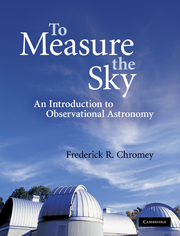10 - Photometry
Published online by Cambridge University Press: 05 June 2012
Summary
The classification of the stars of the celestial sphere, according to different orders of magnitude, was made by ancient astronomers in an arbitrary manner, without any pretension to accuracy. From the nature of things, this vagueness has been continued in the modern catalogs.
– François Arago, Popular Astronomy, Vol I, 1851Astronomers have measured apparent brightness since ancient times, and, as is usual in science, technology has acutely influenced their success. Prior to the 1860s, observers estimated brightness using only their eyes, expressing the results in the uncannily persistent magnitude system that Ptolemy introduced in the second century. As Arago notes, the results were not satisfactory.
In this chapter, after a brief summary of the history of photometry, we will examine in detail the surprisingly complex process for answering the question: how bright is that object? To do so, we will first introduce the notion of a defined bandpass and its quantitative description, as well as the use of such bandpasses in the creation of standard photometric systems. Photometry is most useful if it represents the unadulterated light from the object of interest, so we will take some pain to describe how various effects might alter that light: spectrum shifts, absorption by interstellar material, and the characteristics of the observing system. We will pay particular attention, however, to the heavy burden of the ground-based photometrist: the influence of the terrestrial atmosphere and the techniques that might remove it.
- Type
- Chapter
- Information
- To Measure the SkyAn Introduction to Observational Astronomy, pp. 323 - 367Publisher: Cambridge University PressPrint publication year: 2010

